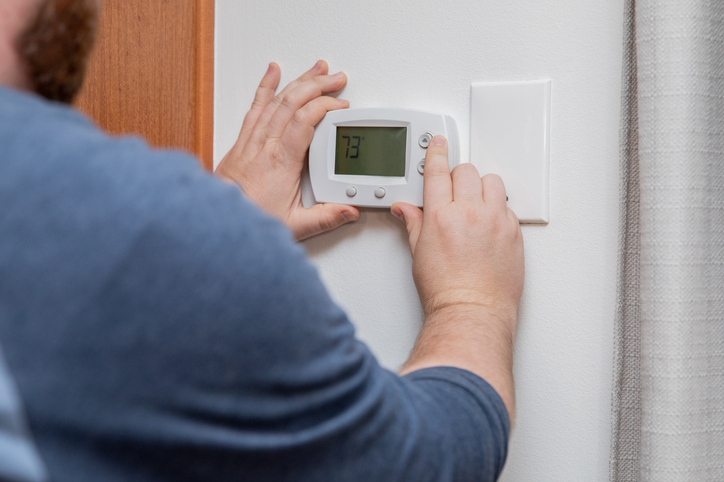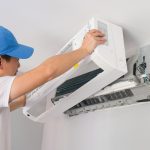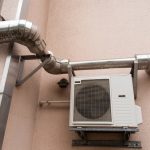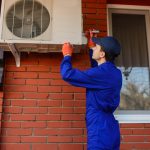
How to Fix an Air Conditioner Thermostat
With record-breaking scorching summer weather, an air conditioner has become essential for most homes. Air conditioning units contain connectors, controls, piping, lines, airflow outlets, and more. Of all these elements, the thermostat is one of the most common parts to cause issues. How do you diagnose and repair thermostat problems? Read on to learn how to fix an air conditioner thermostat.
What Does an Air Conditioner Thermostat Do?
An air conditioner (AC) thermostat plays a critical role in maintaining the comfort of your home. It reads the current indoor air temperature and signals your HVAC system to either cool the space or stay off, depending on your settings. Think of it as a smart switch that responds to environmental changes, turning your system’s compressor and fan on or off to regulate temperature.
When a thermostat isn’t working properly, the entire AC system may behave erratically. You might notice that your home feels too hot or too cold, even if the thermostat settings haven’t changed. Inconsistent indoor temperatures, short cycling, or a system that won’t turn on at all are common signs of a faulty thermostat. Not only does this affect your comfort, but it also leads to wasted energy and higher utility bills.
If you’re experiencing issues with your thermostat, understanding how to fix an air conditioner thermostat can help you determine whether a simple solution is possible, or if it’s time to call in a professional.
Here are some basic steps you can try before replacing the unit:
- Check the Power Source: Make sure the thermostat has power. If it’s battery-operated, replace the batteries. If it’s wired, check your breaker box for a tripped circuit.
- Inspect the Settings: Confirm that the system is set to “cool” and that the temperature is set below the current room temperature. Also, make sure the fan is on “auto.”
- Clean the Thermostat: Dust and debris can interfere with the thermostat’s sensors. Gently open the cover and use a soft brush or canned air to clean it out.
- Test the Wiring: If you’re comfortable doing so, turn off the power and inspect the wiring connections behind the thermostat. Loose or corroded wires may cause malfunctions.
- Recalibrate if Necessary: Some thermostats require recalibration to ensure accurate temperature readings. Refer to your thermostat’s manual or consult an HVAC technician for guidance.
If these steps don’t resolve the issue, you may need a thermostat replacement or a deeper inspection by a qualified HVAC technician. Many homeowners in Arizona find that malfunctioning thermostats are often mistaken for larger system problems. McMillin Air frequently helps customers troubleshoot these issues to avoid unnecessary repairs or replacements.
Knowing how to fix an air conditioner thermostat can save time and money, especially in Arizona, where air conditioning isn’t just a luxury, it’s a necessity. However, when DIY steps don’t do the trick, professional assistance is the safest way to restore full functionality and efficiency.
Signs That You Have Thermostat Issues
There are many indicators of problems with an AC thermostat. The following are suggestions on how to diagnose and fix an air conditioner thermostat.
- The unit is not cooling efficiently: There are many reasons that an AC may not be cooling properly. One of them is thermostat issues. Check for loose or defective wires. Try resetting the thermostat to Auto mode and opening all vents. Remove/debris from around the thermostat housing using a small brush or dry cloth. Never use water.
- Your AC unit won’t turn on: If your unit doesn’t start, check that the thermostat is in cooling mode. Some thermostats require batteries. Check that they have a charge. Call a qualified air conditioning technician if your thermostat requires calibrating or reprogramming.
- The AC unit won’t turn off: If your unit fails to turn off, you may have a short in the wires or a broken thermostat. Contact a reputable HVAC company for help.
- Your thermostat won’t allow a setting change: Check if a child lock is in active mode. Check the circuit box. Examine the AC unit for detached, loose, or corroded wires. If you discover this problem, contact an HVAC technician for assistance.
How McMillin Air Can Help
Troubleshooting an AC thermostat can be complicated, especially if you’re unfamiliar with HVAC systems. While online resources may provide general advice on how to fix air conditioner thermostat issues, attempting repairs on your own can often do more harm than good. Improper handling of electrical components, refrigerant lines, or thermostat wiring can lead to serious safety hazards, including electrical shock, exposure to pressurized gases, or even toxic fumes. Beyond the safety risks, DIY thermostat repair can also reduce system efficiency, cause additional costly repairs down the line, and may even void your manufacturer’s warranty.
That’s why McMillin Air recommends leaving thermostat diagnostics and repairs to trained professionals. Our qualified technicians have the experience to accurately identify whether the problem lies with your thermostat or another part of your air conditioning system. We repair and service all makes and models of AC units, and we do so with the goal of getting your system up and running quickly, without unnecessary upsells or surprises.
If you’re unsure how to fix an air conditioner thermostat, we’ll take the guesswork out of the equation. Our team uses specialized tools to test thermostat performance, wiring, calibration, and sensor accuracy. If a simple repair will do the job, we’ll take care of it efficiently and at a reasonable cost. But if your thermostat failure is part of a larger system issue – or if your unit is outdated and inefficient – we’ll walk you through your options. Should you require a replacement, we’ll help you choose the right brand and size of air conditioner for your home’s specific needs, ensuring long-term comfort and energy savings.
Don’t let a malfunctioning thermostat leave you stuck in Arizona’s extreme heat. Call McMillin Air today to book an appointment with a licensed technician. We’re here to make HVAC repairs simple, safe, and stress-free.








0 comments